ARCHIVED PAGE - PLEASE READ!
This page was written by me a long, long time ago. As such the quality of the writing, photography and/or any conclusions I may have come to simply do not stand up to the levels I consider necessary these days.
I do not believe in deleting things outright though as I feel that these pages form something of a time capsule from an earlier stage in my life, and may still be of some interest to folks who have been coming here for a long time. So instead of deleting this page it has been archived.
PLEASE NOTE THAT THIS PAGE HAS BEEN ARCHIVED, AND SHOULD BE CONSIDERED "FOR INTEREST ONLY" AND NOT BE USED FOR ANY OTHER PURPOSE. LINKS, PRICING ETC ARE LIKELY TO BE OUTDATED AND WILL NOT BE UPDATED.
![]()
Dorcy 2AA 4LED Flashlight. Rating: 78%

This is the 2AA, 4 LED version of Dorcy's increasingly popular range of affordable LED flashlights. In this case in the popular 2AA form factor, with four respectably bright white LED's, a dual mode tailcap switch with a lock out function, a variety of colourful anodised finishes, and a comfortable rubber grip to help you keep a grip on things.
Product Info:
Manufacturer: Dorcy.
Available from: Wal-Mart, various other places, US only.
Price: Original price not known.
Size: Length: 150mm, diameter: 25mm max.
Number of lamps: 4.
Lamp Type: Standard 5mm LED's.
Lamp Current: Unable to measure due to construction. Voltage boost circuit current: 450mA on supplied batteries.
Lamp Colour: White.
Body finishes available: Silver, black, gold, blue, red.
Battery type: 2 AA Alkaline. (Supplied).
Switch Type: Tailcap. Push intermittent on, twist on/off. Lock out function.
Water Resistance: Water resistant, not submersible.
Approximate Beam angle: ~10 Degrees.
Notes: Dorcy MasterCell Batteries supplied with light. No other accessories.
(Beamshot to right is taken from 1 metre, with colour balance set to Fluorescent).
All current/voltage measurements were taken using a Solartron 7045 digital Multimeter unless otherwise stated.
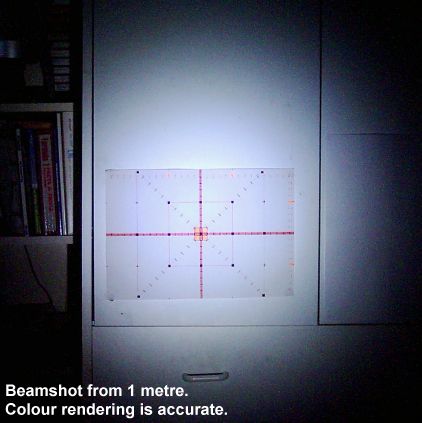
Packing:

The light is supplied in a card backed plastic retail pack. It's of the sonic welded type, so a sharp knife or pair of scissors are required. I managed to get into mine with a pair of scissors, just cutting around the edges of the packing, which was pretty easy, and left everything intact - which for a reviewer is an issue. So getting into the package with bare hands is pretty much impossible - it however doesn't require the use of chainsaws, angle grinders, thermonuclear weapons or other such nonsense which some packs of this type do.
The pack itself, though simple, is very eye-catching. Primarily thanks to the liberal use of holographic material to make up the lettering of "L.E.D." in the title. Graphics are simple, but pleasant, and have the flashlight clearly visible, letting it sell itself pretty much. A battery graph comparing the relative lifetimes of the batteries in an equivalent incandescent based light, and the claims that the LED's never need to be replaced also help though.
The usual usage and battery changing instructions are printed on the back of the packing card, and the batteries are supplied in a separate compartment in the pack, alongside the light itself. The warranty statement is also there as well, all instructions are printed in both English, and what I believe to be Spanish.
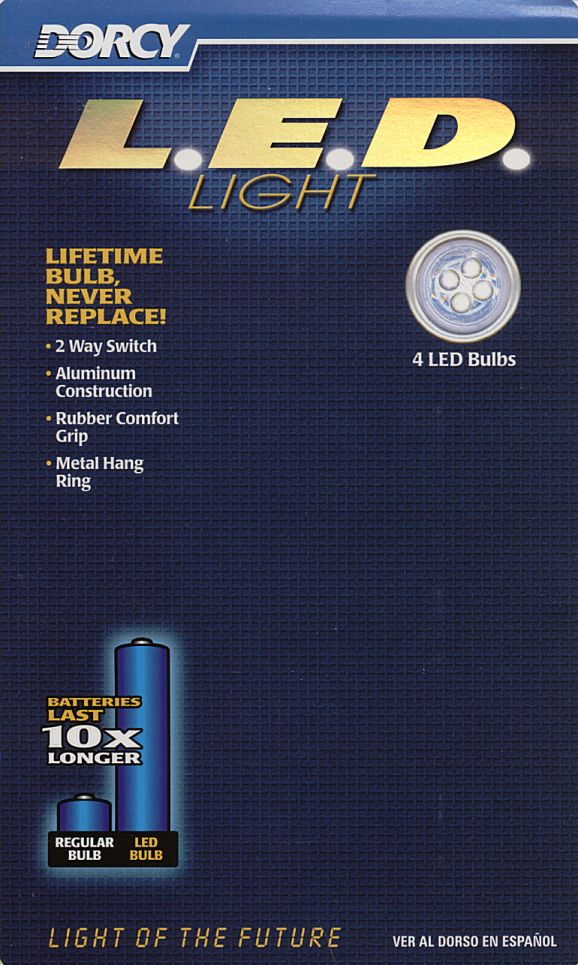
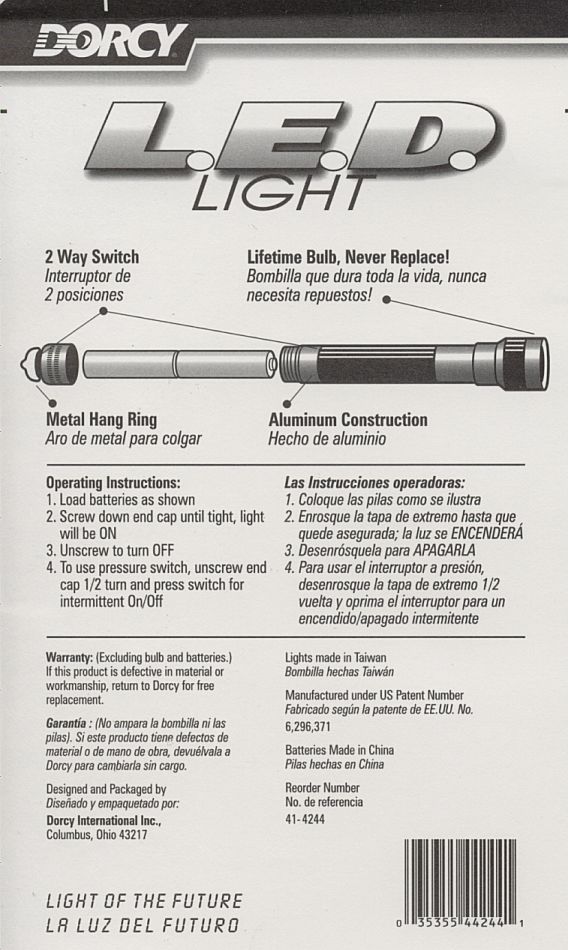
Power Source:
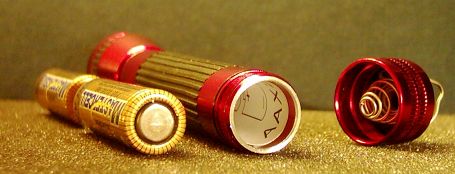
An instant plus for this light, that is uses an even number of the most common battery out there. Two AA cells to be precise. Another plus is that they're dead easy to change too. Battery life is not actually stated on the packaging, it simply makes the bold claim that they last ten times more than in a normal (by normal I am assuming they are referring to a similarly specified incandescent flashlight), so I'll need to run a battery lifetime test at some point. I somehow doubt that the lifetime would be all that impressive given the rather high current draw from new cells, and given how most voltage boost circuits in applications like this work, that current draw will only increase as the voltage supplied by the batteries decreases. Not a good thing at all. Still, won't really know how it performs until I've had a chance to run a set of batteries through it. The deciding factor here really is how far down the voltage boost circuit can drain the batteries. If it can squeeze every last mA out of them, the battery life could well be respectable, if not, it'll prove disappointing.

The meter reading here proves my point. 450mA is a LOT for a light of this type. That would work out as 112mA to each LED. However, the LED's are of course not actually seeing in excess of 100mA each, as there's a voltage boost circuit built into the light to take the 3 volt power supply from the batteries, and change it into the 3.6V or so that the LED's need to light at an acceptable level.
However, (not including circuit efficiency losses), the same amount of power has to be drawn from the batteries, as is seen by the LED's. So that extra power has to come from somewhere...and it means that at the lower voltage from the batteries, the same amount of power equates to a higher current flow, thanks to the simple formula, Power = Voltage x Current (in Amps). In this case, the theoretical power out to the LED's is 1.3W total, which is 90.2mA apiece. Though that's probably 40-50mA actually after circuit losses - that I cannot confirm at the present time, as I don't have the efficiency figures for the boost circuit on hand.
If that explanation lost you somewhat, don't worry - it's a bit on the technical side, and certainly isn't needed to operate this flashlight!
Actually changing the batteries could hardly be easier.
1. All that is required is for you to unscrew and remove the tailcap, and put it somewhere safe - you'll need it later.
2. If they're fitted, remove and dispose of the dead cells in a suitable manner. Obviously, if you're fitting cells for the first time, this step can be skipped.
3. Take two new AA Alkaline cells, and insert them + (nipple) end toward the bezel of the light (There's a piece of paper with a diagram on inside the light if you get confused), then screw the tailcap on. It really is that simple.
Having just checked, the light appears to work perfectly on 1.2V NiCd rechargeable cells, so NiMH ones would work just fine too.
Lamps:
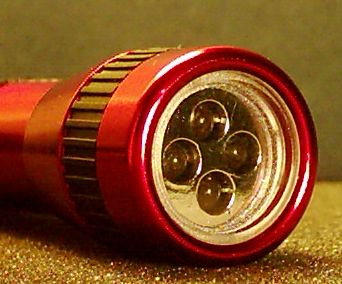
The LED's used in this unit are pretty conventional white LED's, who makes them I do not know. Given the price of the light, I somewhat doubt that they're the more expensive Nichias, but having said that, the brightness and beam colour are actually very good, so they could be. Whoever makes them though, they're good LED's.
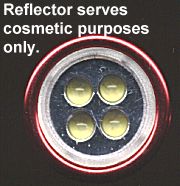
As the pictures here show, this light features four of them, set in a square (or diamond, depending how you look at it) pattern, set into individual cells in a silvered reflector.
This reflector actually does little (if anything) in terms of light direction, though as the insides of the cells the LED's are recessed in are silvered as well, I guess it could aid in redirecting some of the light which escapes the sides of the LED's epoxy case back into the main beam. It does however help to prevent the LED's getting knocked out of alignment, and makes the front of the light look a bit nicer.
The LED's in this light are not intended to be user replaceable, though given that LED's have a service life of something like 100'000 hours, this is hardly an issue. Even though they are probably somewhat overdriven in the case of this light, a figure of well over 5000 hours should still be expected - and that means they'll probably outlast the light, and possibly the owner!
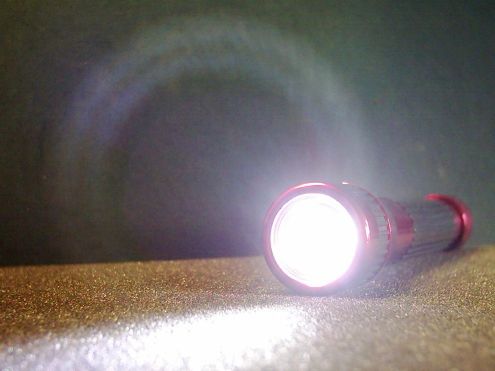
Operation:

This is another light which you don't need to be a rocket scientist to operate. That said, someone used to using a Mini MagLite would find themselves somewhat confused; as unscrewing the head as you would to activate the MiniMag will simply cause the head to fall off.
This light is instead activated in one of two ways using the tailcap as shown in the picture.
To get a brief burst of light, press in the black plastic button on the cap, release the button to get dark...or to turn the light off anyway.
To get sustained light, turn the tailcap (tighten it), until the light turns on. Loosen it again to turn the light off. It's best to only turn it about 3/4 of a turn after the light goes out though so that the intermittent switch still works.
This switch also features a "Lock out" function, to prevent the light from turning on in your bag, pocket or car glove compartment. This is used by unscrewing the tailcap a full turn and a half past the "off" position. When in this position, no matter how hard you press it, the momentary button will not work. Also, given how much further it now has to turn, the chances of the tailcap turning far enough to switch the light on are near zero.
It really can't get much simpler than this. There are no focus controls or fancy brightness level modes to worry about, just those two ways of using the tailcap.
Ergonomics:

Ergonomically speaking, it's hard to complain about this light - it is, physically speaking, very much your "standard" sort of flashlight size and shape. It fits very nicely in the hand, has a nice comfortable rubber grip on both the head and the body, and the switch is nice and easy to get at, and is easily de/activated with one hand.
The tailcap mounted switch does admittedly require some acclimatization if you're used to head or barrel mounted switches, but it doesn't take long to get the hang of it, and once you have, becomes natural very quickly.
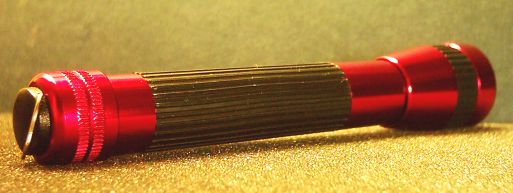
The rubber grips which you can see in the photographs to work precisely as intended, and allow good strong retention of the light even if your hands are wet or greasy, there is also some knurling on the tailcap to aid in turning that under such conditions. The majority of lights would use a knurled pattern on this part, rather than the striped pattern seen here. It has to be said though, that the stripes do have something to be said for them. Primarily that they do exactly what they're meant to - however, they don't make it near impossible to get the light out of your pocket like the knurling on some lights can. As with most rubber grips and or knurling though, these seem to do a really good job of attracting bits of fluff and other gunk that might be floating around in pockets, as can be seen in the photographs! The little white specs there don't come as standard with the light!
There is a hanging loop on attached to the light, in the form of a little wire loop affixed to the plastic button in the tailcap. This does not interfere with the button however, and can be rotated through 180 degrees, so as to stand out at right angles to the button, or lay flat against the tailcap. If you really, really hate the loop however, it's not hard to remove, simply pulls the two ends away from the button, and remove it. If you do this however, you'll have to be more careful when changing the batteries, as it is actually the clip which holds the button into the tailcap, remove the clip, and the button can fall clear through the hole. Even if this happens though, it isn't the end of the world, just pick up the bits and stuff them back in the relevant places. I don't know however how far I'd trust that lanyard hoop - for the very reason that it's easy to remove - to hold the weight of the light itself. I can see it potentially coming adrift really quite easily.
Performance:
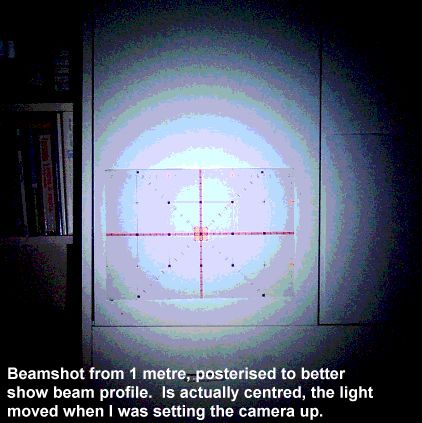
Firstly, a somewhat non-standard brightness comparison. Reads 120 on my camera's light meter from 1 foot. This is not a standard unit that I know of, but I'm including the reading with all new reviews, so can be used to compare some of the lights here.
This light certainly seems to perform well, certainly in the size versus brightness stakes, and particularly for a light of its price.
Due to the fact that this light only uses the lenses built into the epoxy packages of the LED's themselves, this isn't a spotlight which will throw a beam all the way into the next county, but it is a narrow enough beam to illuminate a useful distance in front of you, and to illuminate a useful area, as the beam is reasonably wide.
One thing which always is annoying in multi-LED lights, is if the beam from the individual LED's are misaligned, i.e. you can end up with four distinct beams from four LED's! In this case however, there is no such problem. At and distance past about two inches, the four beams converge into one almost perfectly smooth circular beam. The LED's themselves also appear to be very well matched in colour, though one is very *very* slightly more yellow than the other three, this is totally invisible other than if you're holding a piece of paper up to the light through and looking at what's getting through...and not many people (well...other than people like me!) do that.
There's really not all that much to say here, the pictures do most of that! This is a pretty simple light, aimed at the general market, and it does exactly what it says on the tin, it is an everyday flashlight. Which could take over the role of just about any 2AA incandescent light right now, apart from longer distance work thanks to the fixed medium flood beam.
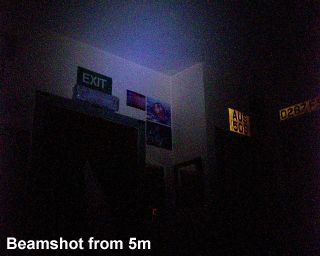
Durability Department:
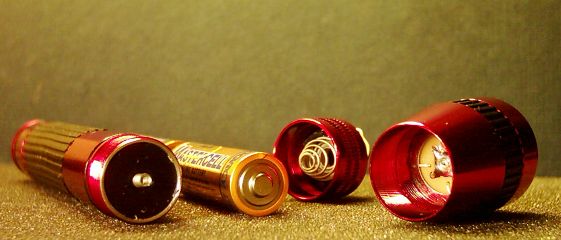
The little Dorcy certainly seems to be pretty sturdy. The relatively small size and LED combo works to its advantage right from the word go, meaning that it shrugs off drops and similar mishaps with utter impunity, though you might put a ding in the anodizing if you drop it on concrete or something like that. That'll just be cosmetic though, and the light will keep right on shining, thanks to the fact that LED's are almost completely impervious to shock/vibration.
The usual tests:
Dropped to the floor from waist height. Result: A loud bang, no damage whatsoever. As expected.
Throw clear across the room from waist height. Result: A considerably louder bang, another one as it bounced off the wall, no damage or malfunction whatsoever.
Beat it against the edge of the desk a bit. Result: A dent in the edge of the desk, light continues operating totally unscathed.
My conclusion: That this is a light which will shrug off everyday mishaps any normal flashlight would expect to encounter without difficulty, though the finish might get a bit scratched over time, and the rubber grips might get a bit tattered, but it'll keep right on going. Despite being a cheap light, the walls are a good 1mm thick, and the threads all look very solid, so I see no reason why this light shouldn't go on and live a very, very long life.
The only area where this light falls down at all really, is waterproofing. Not badly there either. A suction test revealed no leakage in the head or body, or in the rest position the tailcap. If the button is pressed however, the seal is broken. So if the light needs to be submerged, turn it on quite tightly, and you should be okay. It will easily survive a brief dunking anyway I think.
The lens also could be a bit of a weak point. There's nothing actually wrong with it, but it is plastic, and over time will no doubt pick up a few scratches. If it does however get scratched enough to affect the beam, it's not the end of the world, as the lens can be removed (albeit with a bit of a struggle), and getting a replacement shouldn't be too hard, Flashlightlens.com for instance should be able to fix you up good as new.
Overall:
This light (and the whole range of current Dorcy LED lights) are another nail in the coffin of incandescent lighting in terms or small and affordable flashlights for the "average" consumer. It's small, cheap, bright, durable, easy to use, and it looks the part. Oh, and it's cheap too. If you don't have one, go get one. All we REALLY need is a UK distributor!
Keep up the good work Dorcy!
Pros:
+Bright enough to be truly useful
+Uses cheap and easy to find batteries.
+No bulbs to burn out.
+Easy to use.
+Durable.
+Very good beam quality.
+Smart appearance.
+Cheap.
+Feels nice in the hand.
Cons:
-Not fully waterproof.
-Nigh on impossible to find outside the USA.
-Surprisingly high current draw.
Niggles:
>Cannot be stood on tail to light a room by shining on the ceiling. (Some people hate that, I don't care either way myself).
>Tailcap button can be a little unpredictable when new, easily fixed though.
Ratings:
Beam Quality: 8
Build Quality: 7
Battery Life: 5
Durability: 9
Value: 10
Overall: 39 / 50 = 78%
Long Term Testing:
8th June 2004. Uploaded specs and photos. Will start review ASAP.
16th June 2004. Uploaded full review. Will keep you to date if anything of note is discovered.
3rd August 2009: Fixed the page following the server move. The light is actually sitting on the desk next to my monitor right now. Ever since it was received in 2004, it has been used pretty much daily. It's gained a few scratches and dings in the anodizing, and the rubber grip isn't quite as well aligned as it was when new - but it still works perfectly, and is still one of the three lights I'm most likely to grab for any given task (Osram Dulux Mini, or Heliotek HTE-1 being the other two likely candidates). While it's not the most powerful thing in the world, nor is it as well machined as a Surefire, it's just a good product.
5th January 2021: Page retired and moved to Site Archive.
28th April 2023: Revised Statcounter code to allow for HTTPS operation.